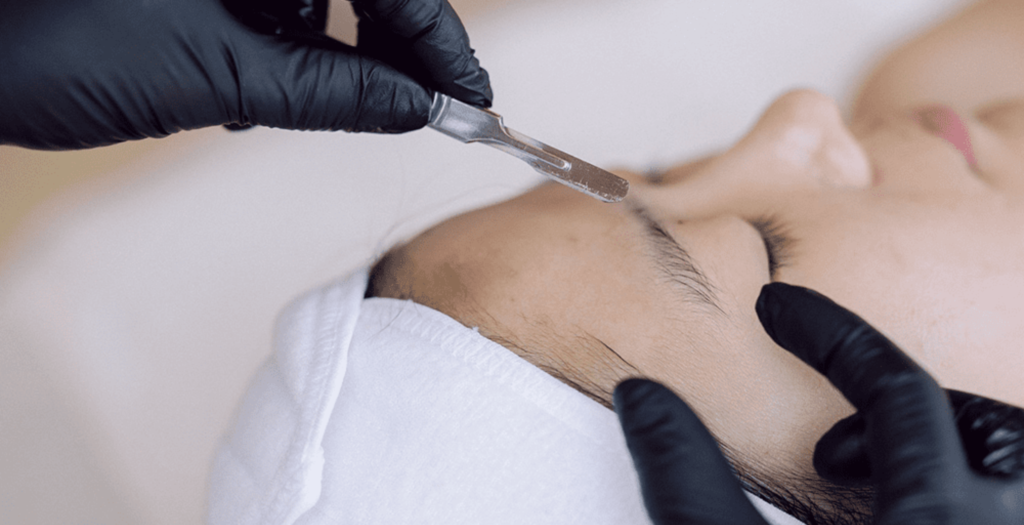
Dermaplaning seems to be everywhere right now. From celebrities to influencers, it seems that more and more people are turning to this trend to achieve a deeper level of exfoliation. So what is dermaplaning anyway? And is a dermaplane facial the right choice for everyone?
What is Dermaplaning?
Dermaplaning is a method of physical exfoliation, instead of using granules, a sterile, surgical scalpel is used to gently “shave” the skin’s surface, removing the top-most layer of dead skin along with fine, vellus hair (a.k.a peach fuzz). Once the skin is properly prepped, the technician holds the skin taut and gently glides the blade along the skin’s surface at a 45 degree angle.
This procedure leaves the skin even more silky smooth than other exfoliation techniques due to the hair removal process. Dermaplaning can even improve the appearance of acne scars, fine wrinkles, and dull, dry skin. It is also known to help skincare products penetrate more easily for better results.
What Are The Benefits Of A Dermaplane Facial?
Dermaplaning clears away vellus hair and damaged skin cells to achieve a smooth, glowing complexion and assists the skin with a deeper absorption of the products applied after the technique is complete, helping soothe, heal and hydrate dry skin. The skin will be left smooth, clear and naturally radiant! A dermaplane facial:
- Is a safe procedure for removing dead skin cells
- Eliminates soft facial hair that traps dirt and oils
- Promotes smoother skin
- Reduces the appearance of acne scars
- Diminishes the look of fine lines
- Works on most skin types
Who can Benefit from Dermaplaning?
Almost anyone with any skin type can benefit from dermaplaning. Prior to your treatment, you will be able to speak with one of our skin care professionals to discuss your medical history, skin type, and skin care goals. Those with active acne may need to wait until their acne is cleared up to schedule an appointment to avoid irritating the skin or spreading bacteria.
Who Shouldn’t Get A Dermaplane Facial?
A dermaplane facial is suitable for most skin types, but you might want to sit this treatment out if you have melasma, risk of PIH, rosacea, cystic acne, risk of PIB, skin irregularities, sensitive skin or if you are new to exfoliation.
There are contradictions to this treatment, including but not limited to diabetes, cancer, active acne, bleeding disorders, and the inability for blood to coagulate following injury. Certain medications including blood thinners, higher dosages of Aspirin, and Accutane are contradicted for this treatment due to increased sensitivity and/or the possibility of delayed clotting from a nick or cut.
This treatment may be further delayed if your skin is inflamed, peeling, swollen, bruised, delayed in healing from another treatment or in any way distressed or any of the conditions below:
- Botox or Fillers – Wait 1 week after injection. It is ok to dermaplane prior to receiving injections. Dermaplaning after injection can move the product causing an undesirable result.
- Retin-A – Stop using 5-days pre and post-treatment.
- Chemical peel – Dermaplaning my be done prior to a peel. Post-peel wait 14+ days depending upon strength and depth of the peel and condition of your skin.
- Laser treatment – May be done prior to treatment with proper training. Post-laser wait 14(+) days depending upon treatment and condition of your skin.
- IPL – May be done prior to treatment with proper training. Post-IPL wait 10+ days depending upon treatment and condition of your skin.
- Prone to PIH (Post Inflammatory Hyperpigmentation) – Pre- and post-treatment for at least 2 weeks prior to and following dermaplaning with appropriate home care which includes melanin suppressants.
- Diabetes – Must be under control by diet or medication
- Cancer – Not while undergoing treatment. Following conclusion of treatments doctor approval required.
- Accutane or Isotretinoin – Ok, after 12 months of non-use and with doctors approval
- Blood thinners or history of bleeding problems/delayed coagulation following injury – No
- Higher dosages or frequency of use of Aspirin – No
- Acne – Grade 3 or above – No dermaplaning
- Pustular acne lesion that is red and irritated – Avoid area or alternative treatment
- Cystic acne lesion – Avoid area
- Cold Sores – No
- Moles & Skin Tags – Avoid area
- Sunburn or windburned skin – No
- Clients who are experiencing high anxiety – No, facial with a scrub is a better option until anxiety is reduced.
As this treatment requires use of a sterile surgical blade, please do not attempt dermaplaning at home as you can easily cause micro-tears and infection in your skin. Dermaplaning is safe when performed in a professional setting by a licensed trained skin care specialist utilizing the appropriate tools and practices for the service.
Is it safe?
It is extremely safe when performed by a professionally trained professional.
How often can this procedure be performed?
Dermaplaning can be performed every 3 to 4 weeks. Treating the skin in this manner actually removes about 2 to 3 weeks worth of dead skin cells. The skin needs the time to complete its normal skin cycle of approximately 28 days before repeating the treatment.
Can dermaplaning be performed with a chemical peel?
Yes, Dermaplaning is an excellent way to prepare the skin for a chemical peel. Post-peel wait 14+ days depending upon strength and depth of the peel and condition of your skin.
Does the skin actually peel from dermaplaning?
No. When dermaplaning is performed as a preparation for a chemical peel, the visible exfoliation that the guest sees will be a result of the peel solution used in the treatments.
Can i dermaplane the day of my wedding or big event?
We recommend dermaplaning several days before a big event – especially brides. If this is the first time a guest is being dermaplaned, this is even more important in case there is a reaction to either dermaplaning or the products used on the skin following treatment.
What to Expect?
About one week prior to your dermaplaning treatment, we recommend avoiding sun exposure, as treatment on sunburned skin will make the treatment painful.
During your Dermaplaning treatment, a special exfoliating blade will be gently dragged across the skin to skim off dead skin cells and vellus hair from the face. Once the Dermaplaning is complete, we add an enzyme exfoliating + a hydrating mask followed by customized serums and lastly sunscreen to protect your face. There is typically no downtime associated with dermaplaning.
Dermaplaning guests will be able to enjoy their results for about three to six weeks. Repeated treatments are recommended. It is important that you wear sunscreen following Dermaplaning because your skin is vulnerable to sum damage which can create pigmented blotches on your fresh skin.
Post-Facial Care
The number one thing to remember after a dermaplane facial is that your skin will be much more sensitive to the sun and other environmental factors. While this is true of any facial, this is especially important after a dermaplane facial as a deeper level of exfoliation has occurred. Ensure you are using SPF protection on your face immediately after the procedure and reapply often to keep your skin radiant and healthy.


